Consumer Price Index
Consumer Price Index (CPI) is the general measure of the change in the average retail prices of a market basket or collection of goods and services commonly purchased by the average Filipino household.
The CPI of the Cordillera Administrative Region (CAR) in May 2023 was 118.5. This was higher by 4.4 index points from the 114.1 CPI of May 2022 using 2018 as the base year.
In general, the CPI increased reflecting the rise in the average prices of goods and services in all the six provinces and one highly-urbanized city (HUC) of CAR.
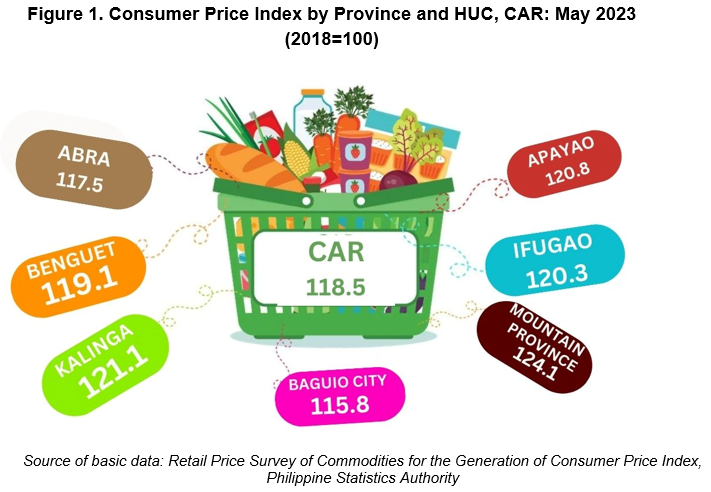
Among the CAR provinces and HUC, Mountain Province posted the highest CPI in May 2023 with 124.1, followed by Kalinga with 121.1, and Apayao with 120.8. On the other hand, Baguio City recorded the lowest CPI with 115.8.
CPI by Commodity Groups
Among the commodity groups, Alcoholic Beverages and Tobacco had the highest CPI in the region with 149.2 index points. Among the provinces, Mountain Province had the highest index on Alcoholic Beverages and Tobacco with 172.0 while Benguet had the lowest with 134.6 index points.
Financial Services posted the second highest CPI in May 2023 among the commodity groups with 139.2 index points. Among CAR provinces, Abra recorded the highest CPI on this commodity with 160.4 index points, followed by Apayao, Benguet, and Kalinga with 146.0 index points each.
Transport registered the third highest CPI with 126.8 index points. Apayao recorded the highest index on transport with 139.3, followed by Benguet and Ifugao with 137.6 and 128.1 index points, respectively.
Information and Communication continued to incur the lowest CPI among the commodity groups in the region during the month of May 2023 with 102.0 index points. The province of Apayao posted the highest index on Information and Communication at 103.3 index points while Ifugao and Mountain Province registered the lowest both with 99.9 index points.
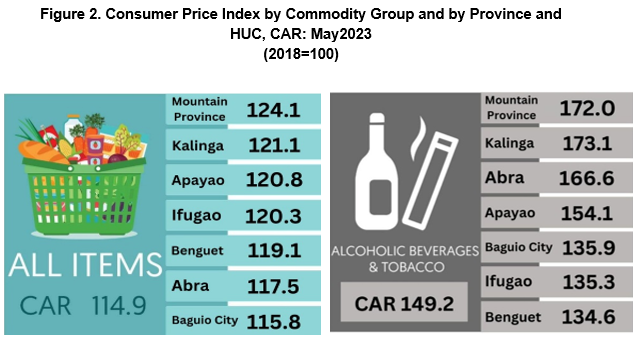
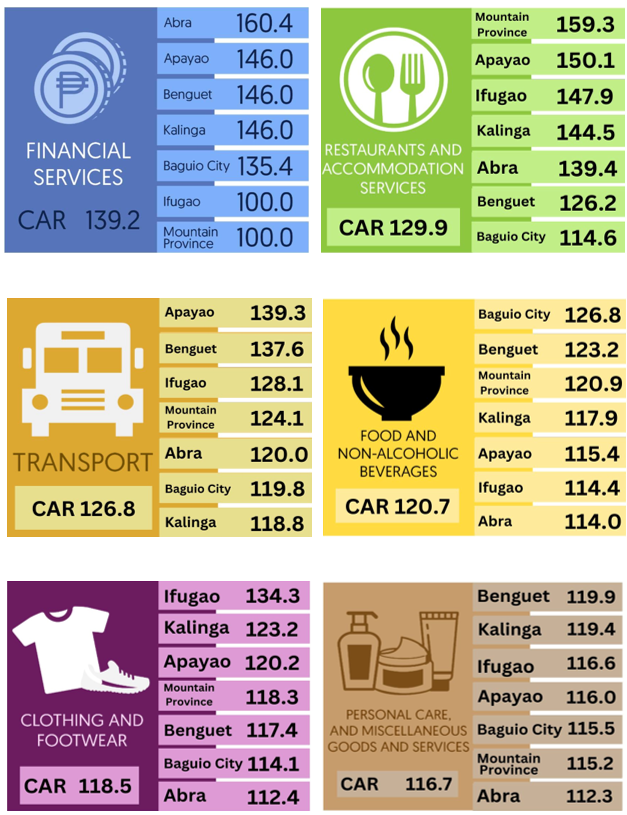
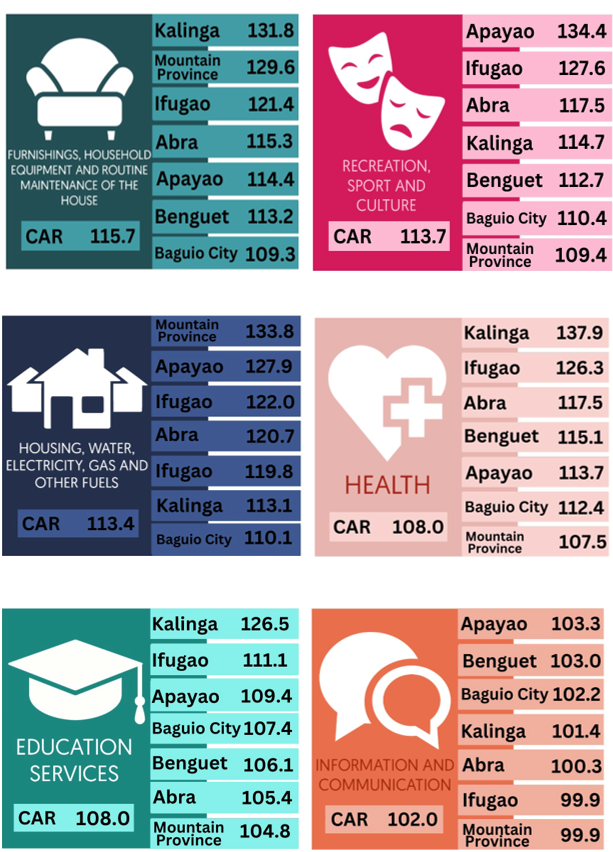
Meanwhile, the CPI of the heavily-weighted Food and Non-Alcoholic Beverages ranked fifth among all commodity groups with 120.7 index points. Across provinces and HUC, the City of Baguio recorded the highest index on Food and Non-Alcoholic Beverages with 126.8 index points. This was followed by Benguet, Mountain Province, and Kalinga with 123.2, 120.9, and 117.9 index points, respectively. On the other hand, the province of Abra incurred the least index on the commodity with 114.0.
By index point change, Alcoholic Beverages and Tobacco posted the highest increase (9.1 points). This was followed by Restaurants and Accommodation Services and Food and Non-alcoholic Beverages with 7.1 and 6.7 index points increase, respectively. Increases were observed in all commodity groups with Information and Communication (0.1 point) having the lowest increase.
The CPI of Financial Services remained constant relative to its recorded index in the same month of the previous year.
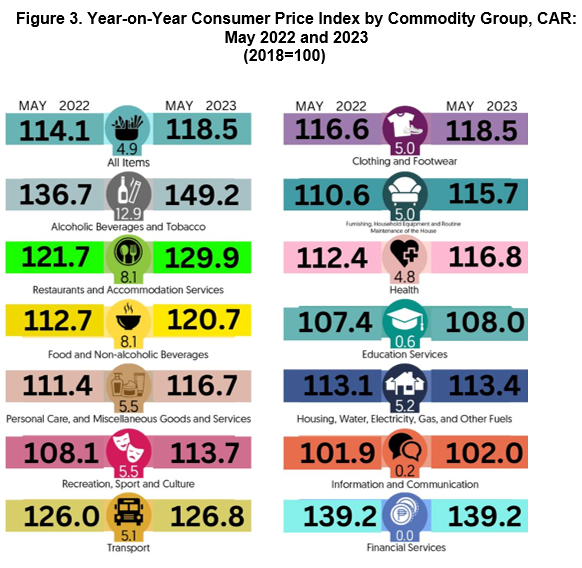
Inflation Rate
The average increase in the prices of goods and services in the region decelerated to 3.9 percent in May 2023, from 4.3 percent in April 2023. In addition, this was lower by 3.0 percentage points compared to the 6.9 percent inflation recorded in May 2022.
Out of the 13 commodity groups in the market basket of the region, eight posted lower inflation rates compared to April 2023. These were Food and Non-Alcoholic Beverages (7.1 percent); Alcoholic Beverages and Tobacco (9.1 percent); Clothing and Footwear (4.3 percent); Housing, Water, Electricity, Gas, and Other Fuels (0.3 percent); Health (3.9 percent); Transport (0.6 percent); Information and Communication (0.1 percent); and Personal Care, and Miscellaneous Goods and Services (4.8 percent).
On the other hand, two commodity groups registered higher inflation rates compared to May 2022. These were Furnishing, Household Equipment and Routine Household Maintenance (4.6 percent) and Recreation, Sport, and Culture (5.2 percent).
The inflation rates of Education Services, Restaurant and Accommodation Services and Financial Services remained constant in May 2023.
Apayao posted the highest inflation rate in May 2023 with 6.1 percent, followed by Abra with 4.6 percent, and Mountain Province with 4.5 percent. The City of Baguio incurred the lowest inflation among the provinces and HUC of CAR with 3.0 percent.
Moreover, Abra and Baguio City recorded inflation rates that were higher than May 2022 figures.
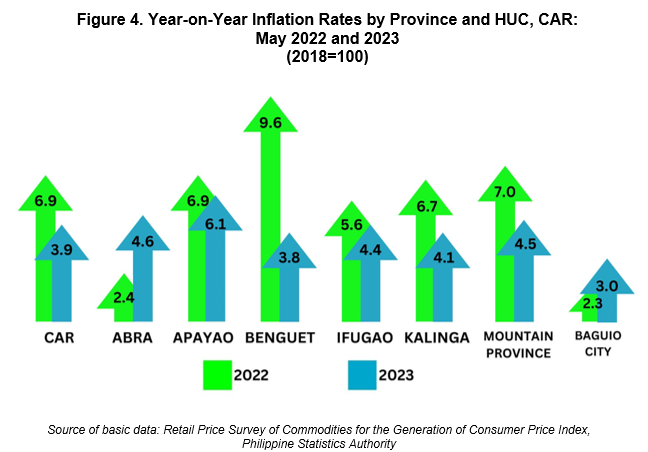
By Commodity Group
Inflation rate of the heavily-weighted Food and Non-Alcoholic Beverages in May 2023 was lower by 0.1 percentage points compared to the same month of the previous year.
Alcoholic Beverages and Tobacco recorded the highest inflation rate among all commodity groups in the region with 9.1 percent in May 2023 followed by Food and Non-alcoholic Beverages and Restaurants and Accommodation Services with 7.1 and 6.7 percent, respectively.
Among all commodities, the rate of Education Services, Restaurants and Accommodation Services and Financial Services remained constant relative to the rate recorded in the previous month.
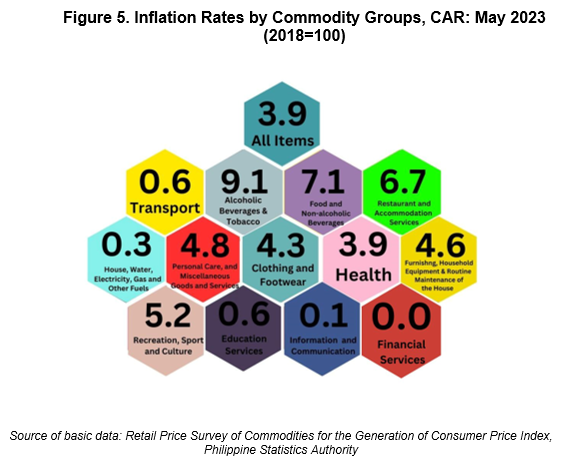
By Food Items, Year-on-Year
Among the food items, Corn recorded the highest CPI in the region in May with 170.7 index points. This was followed by Sugar, Confectionery and Desserts; Fish and other Seafood; and Fruits and Nuts with 145.7, 136.4, and 135.2 index points, respectively.
In terms of inflation rate, Sugar, Confectionery and Desserts registered the highest rate with 34.2 percent; followed by Milk, Other Dairy Products, and Eggs with 15.8 percent; and Corn with 12.2 percent. On the other hand, Rice recorded the lowest rate in May 2023 with 2.2 percent.
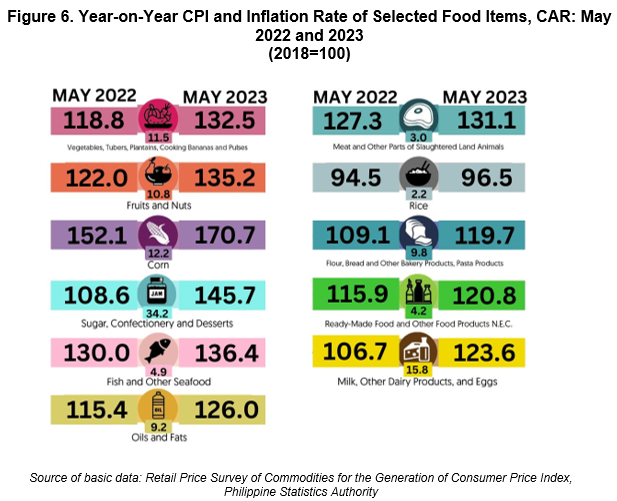
Purchasing Power of the Peso
The Purchasing Power of the Peso (PPP) in all the provinces and HUC of CAR weakened in May 2023 compared to the same month of the previous year.
The value of one peso in 2018 in the region was 84 centavos in May 2023. It dropped by five centavos from the 89-centavo worth of the peso in May 2022. Across provinces and HUC, Baguio City had the highest peso value at 86 centavos, higher than the regional value. This was followed by Abra with 85 centavos and Benguet with 84 centavos. Meanwhile, Mountain Province had the lowest peso value at 81 centavos.
In the same manner, a hundred pesos in 2018 was worth 84 pesos in May 2023.
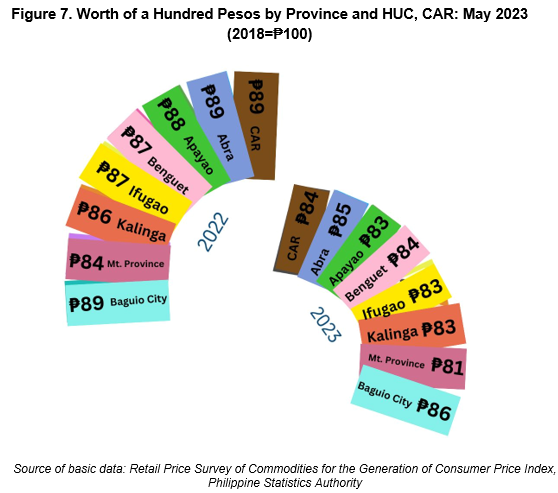
(SGD)
VILLAFE P. ALIBUYOG
Regional Director
________________________________________________
TECHNICAL NOTES
Consumer Price Index (CPI) is a general measure of the change in the average retail prices of a market basket or collection of goods and services commonly purchased by the average Filipino household.
Inflation Rate (IR) is the rate of change in the average price level between two periods (year-on year/month-on-month as measured by the CPI).
Purchasing Power of the Peso (PPP) measures how much the peso in the reference year is worth in another year.
Base Year (BY) is the reference point of the index number series, at which the index number is set to 100. It is the reference point of the index number series.
The CPI is now rebased to 2018 base year from the 2012 base year. The year 2018 was chosen as the next base year because it was the latest year when the Family Income and Expenditure Survey (FIES) results were made available.
The rebasing of the CPI is done periodically by the PSA due to the following: 1) to ensure that the CPI market basket continues to capture goods and services commonly purchased by households over time; 2) to update expenditure patterns of households; 3) to synchronize its base year with 2018 base year of the Gross Domestic Product and other indices produced by PSA such as the Producer Price Index (PPI) for Agriculture; PPI for Manufacturing; and Value of Production Index (VaPI), Volume of Production Index (VoPI), and Value of Net Sales Index (VaNSI) for Manufacturing.
Market Basket (MB) is a sample of goods and services commonly purchased by the households.

